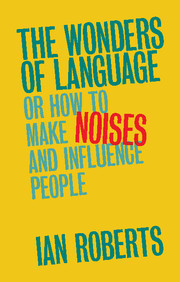
-
Select format
-
- Publisher:
- Cambridge University Press
- Publication date:
- February 2017
- February 2017
- ISBN:
- 9781316576595
- 9781107149939
- 9781316604410
- Dimensions:
- (228 x 152 mm)
- Weight & Pages:
- 0.39kg, 238 Pages
- Dimensions:
- (228 x 152 mm)
- Weight & Pages:
- 0.3kg, 238 Pages
You may already have access via personal or institutional login
Book description
Ian Roberts offers a stimulating introduction to our greatest gift as a species: our capacity for articulate language. We are mostly as blissfully unaware of the intricacies of the structure of language as fish are of the water they swim in. We live in a mental ocean of nouns, verbs, quantifiers, morphemes, vowels and other rich, strange and deeply fascinating linguistic objects. This book introduces the reader to this amazing world. Offering a thought-provoking and accessible introduction to the main discoveries and theories about language, the book is aimed at general readers and undergraduates who are curious about linguistics and language. Written in a lively and direct style, technical terms are carefully introduced and explained and the book includes a full glossary. The book covers all the central areas of linguistics, including phonetics, phonology, morphology, syntax, semantics and pragmatics, as well as historical linguistics, sociolinguistics and psycholinguistics.
Contents
Further Reading
Since this isn’t a textbook, I’ve avoided peppering the text with references and further reading, simply mentioning the key names here and there (Chomsky, de Saussure, Grimm, Labov, Austin, Grice, Greenberg and a few others). But I do want to encourage you to go on, and so here are a few things that you might find interesting and enjoyable now you’ve got this far. The first set are all general references; there are of course plenty of textbooks on all of the various areas of linguistics, and I’ve indicated the best ones to start with if there’s a particular area you want to read about in more detail. Of course, there are lots more textbooks on the various subareas, but you can get to those later by following the references in the readings suggested here. It’s very important to start with an overview of the whole field and not to specialise too much too soon.
General Introductions
Specific Topics
Sign Language
Phonetics
Phonology
Morphology
Syntax
Semantics
Pragmatics
Historical Linguistics
Sociolinguistics
Psycholinguistics/Language acquisition
Language Typology
Metrics
Altmetric attention score
Full text views
Full text views help Loading metrics...
Loading metrics...
* Views captured on Cambridge Core between #date#. This data will be updated every 24 hours.
Usage data cannot currently be displayed.
Accessibility standard: Unknown
Why this information is here
This section outlines the accessibility features of this content - including support for screen readers, full keyboard navigation and high-contrast display options. This may not be relevant for you.
Accessibility Information
Accessibility compliance for the PDF of this book is currently unknown and may be updated in the future.


